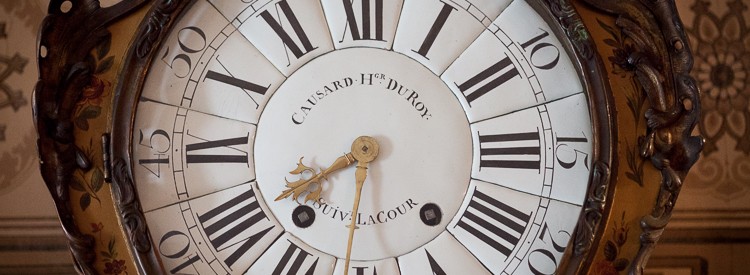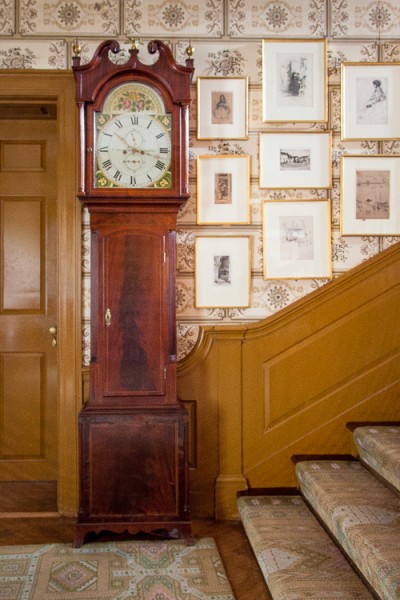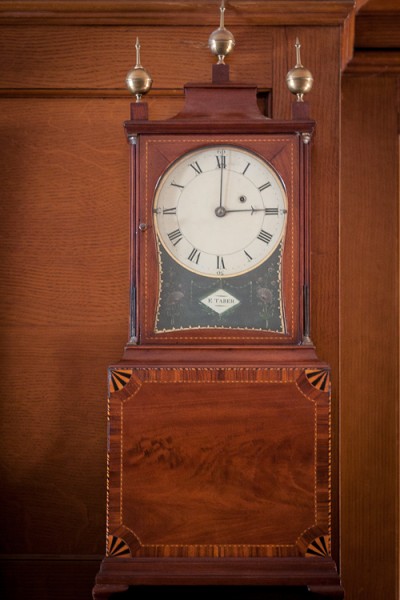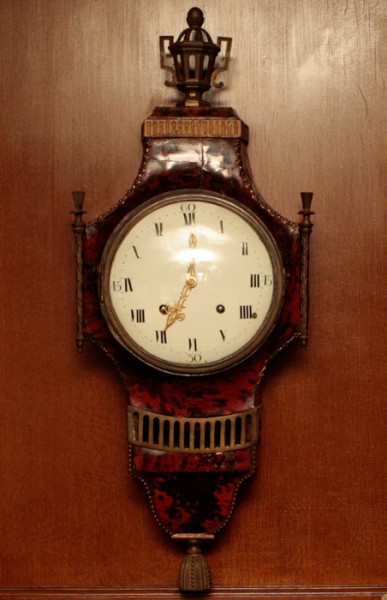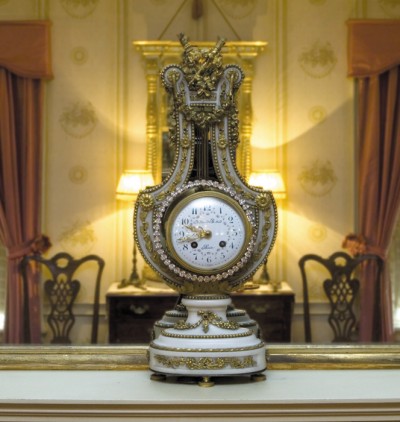Nearly every public room at Hill-Stead has a clock on display. The diverse collection includes American, English, French and Scottish varieties. Numerous bracket or shelf clocks made of wood, marble or brass are exhibited, as is one tall case clock. Notable are a 19th-century timepiece by Massachusetts clock maker Elnathan Taber, a c. 1820 Scottish tall case clock with an enameled dial by Robert MacAdam, and an unusual water clock thought to be a 19th-century reproduction of a 17th-century English piece. A French Louis XVI clock with a rhinestone studded pendulum, modeled after a clock owned by Marie Antoinette, is another significant piece.
Tall case clock
Mahogany, Brass, Glass & Silver
Made in Dumfries, Scotland ca. 1820 by Robert MacAdam, this eight-day, rack-striking clock has a weight-driven movement. The face is enamel over metal, hand painted in multi-colored florals. Clock hands are gilded brass with second and calendar dials in addition to the time-keeping dial. As is the case with this clock, located in the Entrance Hall at Hill-Stead, tall case clocks were frequently placed in central halls so the time could easily be seen as people ascended or descended the stairs.
The term “grandfather” clock did not come into usage until after 1876, with the popularity of the song that began, “My grandfather’s clock was too tall for the shelf so it sat ninety years on the floor.”
Mantel clock
Wood & Brass, ca. 1860
Made by Elnathan Taber
This shelf clock is one of only two American-made clocks in the collection. Elnathan Taber (1768-1854) was a Roxbury, MA clockmaker who served his apprenticeship under celebrated American clockmaker Simon Willard. This style of shelf clock, known as a box-on-box, was made almost exclusively in Massachusetts. The weight-driven movement of the clock requires the higher case. The case, not made by Taber, features fine-figured mahogany and inlaid fan motifs.
Swiss wall clock
Tortoiseshell, gilded wood, ormolu mounts, ca. 1798-1800
This Swiss tortoiseshell wall clock is rare in that Switzerland is known primarily for watch making, not clock making. The style of the case is distinctly Swiss. It was made in the Neuchâtel region and was made ca. 1798-1800 but inspired by the Louis XVI Parisian style. It features a simple face with gilt hands. The eight-day striking mechanism required winding only once a week. The red tortoiseshell serves as a primary color in the décor of Hill-Stead’s First Library, where this clock is displayed above the fireplace.
Louis XVI-style clock
Gilt bronze, marble, rhinestones, ca. 1860-1870
This lyre-shaped clock is a 19th-century reproduction of an 18th-century design that was fashionable in the French court during the reign of Louis XVI. The clock is made of white marble with gilded bronze and a suspended ring pendulum fitted with rhinestones. The face is marked with renowned clockmaker Ferdinand Berthoud’s name, though he was no longer living at the time this clock was made. The clock was finished by Testot & Fils in the style of Berthoud. Legend has it that this is a copy of a clock once owned by Marie Antoinette, except hers featured diamonds on the pendulum instead of rhinestones. This image shows the reflection in the mantle mirror, against which this clock sits, of the first floor guest bedroom.
